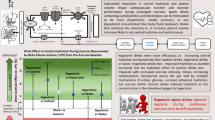Summary
The microgravity environment can be expected in man to induce a swelling of facial tissues and a shrinking of the tissues in the lower limbs together with a loss in body weight. To quantitate fluid shifts into and out of superficial tissues an ultrasound A-mode method was used in one cosmonaut during a 7-day spaceflight. Measurements were taken from frontal and tibia tissues, where the underlying bone provides a good backwall echo. During the spaceflight the cosmonaut showed a swelling of facial tissues during the first 3 days. At the same time the superficial tissues of the caudal areas shrank by 20%. In space he lost 7.7% of body weight. After the spaceflight the superficial tissues were dried out but regained their water content within the next 4 days even before body weight returned to control level. Per kilogram of body weight an increase of 400 cm3 entered the superficial tissue layers of the body. It is concluded that water loss as well as wasting of tissues contribute to the loss in body weight during space flight.
Similar content being viewed by others
Abbreviations
- BW:
-
body weight
- BDC:
-
baseline data collection
References
Aukland K (1987) Interstitial fluid balance in experimental animals and man. Adv Microcirc 13:110–123
Aukland K, Nicolaysen G (1981) Interstitial fluid volume: local regulatory mechanisms. Physiol Rev 61:556–643
Baisch FJ (1993) Applied potential tomography shows differential changes in fluid content of leg tissue layers in microgravity. Clin Investig 71:690–699
Kirsch KA, Merke J, Hinghofer-Szalkay H, Barnkow M, Wicke HJ (1980) A new miniature phlethysmograph to measure volume changes in small circumscribed tissue areas. Pflügers Arch 383:189–194
Kirsch KA, Merke J, Hinghofer-Szalkay H (1980) Fluid volume distribution within superficial shell tissues along body axis during changes of body posture in man. The application of a new miniature phlethysmographic method. Pflügers Arch 383:195–201
Kirsch KA, Röcker L, Gauer OH, Krause R, Leach C, Wicke HJ, Landry R (1984) Venous pressure in weightlessness. Science 255:218–219
Kirsch KA, Haenel F, Röcker L, with technical assistance of Wicke HJ (1986) Venous pressure in microgravity. Naturwissenschaften 73:447–449
Laurent TC (1987) Structure, function and turnover of the extracellular matrix. Adv Microcirc 13:15–34
Moore TP, Thornton WE (1987) Space shuttle inflight and postflight fluid shifts measured by leg volume changes. Aviat Space Environ Med 58[Suppl 9]:A91-A96
Parazynski SE, Hargens AR, Tucker B, Aratow M, Styf J, Crenshaw A (1991) Transcapillary fluid shifts in tissues of the head and neck during and after simulated microgravity. J Appl Physiol 71:2469–2475
Thornton WE, Hoffler GW, Rummel JA (1974) Anthropometric changes and fluid shifts. In: Johnston RS, Dietlein LF (eds) The proceedings of the Life Science Symposium. Publication JSC-09275, NASA TMX-58154:637–658, Houston
Author information
Authors and Affiliations
Rights and permissions
About this article
Cite this article
Kirsch, K.A., Baartz, FJ., Gunga, HC. et al. Fluid shifts into and out of superficial tissues under microgravity and terrestrial conditions. Clin Investig 71, 687–689 (1993). https://doi.org/10.1007/BF00209721
Received:
Revised:
Accepted:
Issue Date:
DOI: https://doi.org/10.1007/BF00209721




